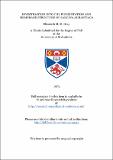Files in this item
Investigation into the pigmentation and membrane structure of sarcina aurantiaca
Item metadata
| dc.contributor.advisor | Thirkell, David | |
| dc.contributor.author | Gray, Elizabeth M. M. | |
| dc.coverage.spatial | 144 p. | en_US |
| dc.date.accessioned | 2018-06-14T09:17:59Z | |
| dc.date.available | 2018-06-14T09:17:59Z | |
| dc.date.issued | 1973 | |
| dc.identifier.uri | https://hdl.handle.net/10023/14043 | |
| dc.description.abstract | The optimum temperature for both growth and. pigmentation of S. aurantiaca was found to be 28°. Growth of S. aurantiaca was limited above 40°. Pigmentation was maximal 65 hours after maximum bacterial numbers were obtained, but began to decline rapidly. Growth only occurred to any substantiated degree within narrow pH limits. The total membrane fraction from S. aurantiaca cells harvested at 17 hours (exponential phase), 27 hours (early stationary phase) and 57 hours (late stationary phase) were analysed to determine if any change occurred in the chemical components of the membranes from the exponential to the late stationary phases of growth. The percentage composition of the membrane components in all three membrane fractions were within the range of values reported for membranes isolated from other Gram-positive bacteria. Membranes from the two stationary phase cultures had a similar quantitative chemical composition but both differed in several respects from the membranes isolated from the exponential phase culture. The protein content remained approximately constant throughout the growth phases but the lipid content decreased and the carbohydrate content increased, with age. Since the overall recoveries of organic material from the total membranes decreased with age, it is thought that this could be explained by increased binding of the lipid to protein which would mean decreased lipid extraction and anomalously low lipid contents. This is substantiated by the observed increase in the relative amounts of the bound lipid and phospholipid fractions with age. Analysis of the lipid showed the presence of an unusually high amount of neutral lipid and a lo\v quantity of phospholipid in all three membrane prep0,rations, as compared with those found in other membranes. The fatty acids found in all the membrane hydrolysates were generally typical for a Gram-positive bacterium but there were considerable variations in the relative quantities of the individual fatty acids with age. Amino acid analysis indicated an amino acid content similar to membranes isolated from other sources, and there were again variations in the molar ratios of the amino acids with age. The monosaccharides detected in all the membrane preparations were galactose, glucose, mannose and ribose. The hexoses were shown to be constituents of the glycolipid and oarotenoid glycopeptide fractions. Only trace amounts of galacatosamine and glucosamine were found. All the carotenoids detected in a 27 hour culture of S. aurantiaca were shown to be derived from carotene. The free pigment consisting of carotene, zeinoxanthin and a dihydroxy carotene formed approximately 29% of the total pigment. The remaining 71% were carotenoid glycopeptides where the carotene most probably linked to galactose, glucose, mannose and to amino acids/peptides. The hexose moieties were linked to carotenoid and/or peptides or other hexose moieties by glycosidic bonds involving their reducing groups. Amino acid analysis of a water soluble carotenoid glyopep tide indicated an amino acid composition similar to the total membrane protein. This carotenoid glycopeptide appeared to be homogeneous despite the inclusion of three different hexoses. S°20 values of the carotfenoid glyopeptide indicated a molecular weight of the order of 20,000. | en_US |
| dc.language.iso | en | en_US |
| dc.publisher | University of St Andrews | |
| dc.subject.lcc | QR82.C7G8 | |
| dc.subject.lcsh | Corynebacteriaceae | en |
| dc.title | Investigation into the pigmentation and membrane structure of sarcina aurantiaca | en_US |
| dc.type | Thesis | en_US |
| dc.type.qualificationlevel | Doctoral | en_US |
| dc.type.qualificationname | PhD Doctor of Philosophy | en_US |
| dc.publisher.institution | The University of St Andrews | en_US |
This item appears in the following Collection(s)
Items in the St Andrews Research Repository are protected by copyright, with all rights reserved, unless otherwise indicated.

